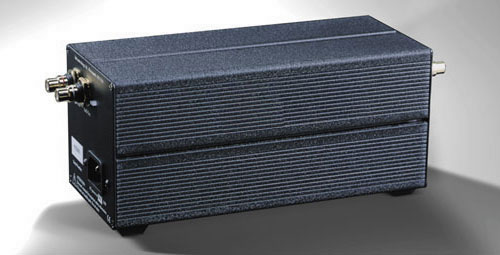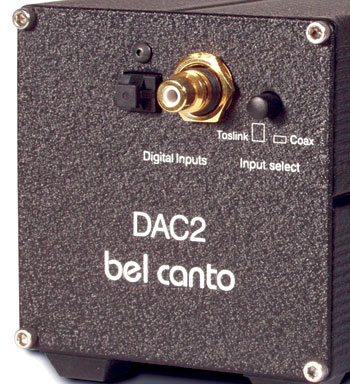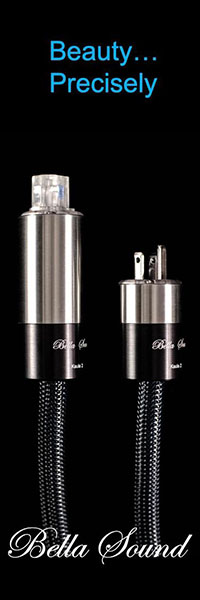The Bel Canto DAC2
| The Bel Canto DAC2 |
|
Unequivocal Saneness in a Crazy World |
|
Dan Dzuban |
|
October 2004
|

Sure We Have Essay CDs
The state of the high-resolution audio format is best summed up by a conversation I had with a clerk at one of Los Angeles’ most revered CD stores:
Me: Do you have any DVD-Audio discs?
Him: Hmm. Well, our movie section is over there.
Me: That’s not what I mean. How about SACDs?
Him: Hmm. Oh, yeah. Sure, we have essay CDs—they are right there in the
Spoken Word section.
Me: Yeah… Uhh, great. Thanks.
Since that time, thankfully, more and more titles have been released on both formats. But this is still not enough for what I would personally consider “critical mass.” Critical mass to me would mean enough titles on one format so that there is clearly one winner in the format wars, or at a minimum, enough titles so that at least some of the music I care about is in high-resolution. Not only to this day are there not enough titles, but the ones that have been released often have not been given the technical attention necessary to motivate me into the purchase of the disc, let alone the hardware to play it. For example, I remember reading a review of either a Fleetwood Mac Rumors release, or The Eagles’ Hotel California (can’t quite remember). The bottom line is that the album was remastered for surround, but the 2 channel mix was untouched; it was merely upsampled to the new high-resolution format rather than recorded in high-resolution directly from the analog master. That is unacceptable. How is that different from upsampling it myself via an upsampling CD player or DAC? Of course I would not have to buy a new disc to do that …
So not only are there not enough titles in high-resolution, but the music industry is often not willing to remaster what they release INTO high-resolution (Unless you want multi-channel, which I don’t. But that is another issue for another time.). I am not here to argue over how many such titles have been short changed sonically, or how many respective titles we are up to for DVD-A or SACD. My point is simply that I have not been motivated to want to divert discretionary income to a component that has a risky sonic return.
Now grant it, more and more manufacturers are bypassing the issue by releasing universal players, but you still have got to pay to play to get the kind of performance worthy of high end. And that is a matter of economics; even if I can finally justify taking the plunge to a universal player, this purchase still has to be a better allocation of my audio resources than an other purchase. In other words, will that three grand I drop on a universal player make more of an impact on my system than a three grand amplifier or speaker upgrade? Likely not.
Rumors of My Death Have Been Greatly Exaggerated
The word in industry circles over the last few years is that the DAC is dead as a commercially viable component. By and large, even hardened audiophiles would rather have a simpler single-box solution for digital playback. When you figure in the fact that your significant other will appreciate the reduced clutter, the DAC (along with anti-jitter box, multiple cables, powers supplies, etc., etc.) looks less and less appealing as a commercially viable product. But now enter the unsettled reality of high-resolution audio; apparently there are very few SACD, DVD-A, or Universal Players that do Redbook CD justice—especially at affordable prices. Hmm. Now the outboard DAC seems to have found a reason for being.
With a DAC you can rely on for CD, you can experiment willy-nilly with the other formats. In fact, without doing an exhaustive comparison, you could put together quite a killer system built around a solid DAC such as the DAC2, and a relatively inexpensive DVD/DVA-A/SACD player. I am not here to argue that a cheap player would make as good of a transport as a thoroughbred player, but I will assert that you will get more bang for your buck when the emphasis is on the DAC rather than the transport (caveat being—at least for systems that cost in the multi thousands rather than multi ten thousands).
 Also keep in mind the DAC2 is quite affordable considering its capabilities in a world of dacs that cost many times more. At 3.5 lbs, and physically longer than it is wider, the DAC2 can easily sit freely among external power supplies without being noticed. Its digital inputs are minimal, supporting only plastic and coax, but my hunch is every time you add an input you add to the price. Bel Canto wanted to keep this product affordable.
Also keep in mind the DAC2 is quite affordable considering its capabilities in a world of dacs that cost many times more. At 3.5 lbs, and physically longer than it is wider, the DAC2 can easily sit freely among external power supplies without being noticed. Its digital inputs are minimal, supporting only plastic and coax, but my hunch is every time you add an input you add to the price. Bel Canto wanted to keep this product affordable.
Comparisons
Compared to my stock aging Toshiba DVD player…well…there was no comparison. Go down the line, and every conceivable sonic trait was dramatically improved. But this doesn’t tell you much now though, does it?
Comparison to my current reference Quad 99 CDP is much more appropriate. At right around $1500, I also consider the Quad quite a bargain. Both components sounded pretty similar overall. Similar tonal balance and treble/bass balance and extension. No difference in soundstaging, imaging or high frequency air. However, in direct comparison, the Quad had a lighter touch than the DAC2, which sounded a bit more colorful with a bit more body throughout the midrange and bass. The DAC2 also had a slightly warmer harmonic presentation, which made images a tad more dimensional. This gave the DAC2 seemingly more dynamics and bass punch as well as a more convincingly real presentation. And this last trait is really what most of us are after now isn’t it? As such, I enjoyed the Hell out of the DAC2 when listening to my usual acoustic-oriented standards such as Chris Isaak; Sade, or even Jimmy Buffett. And similar to my Audio Harmony review of yore, it made my treasured 80’s pop recordings that much more listenable—but to a much lesser degree than the differences Audio Harmony wrought. I guess to be specific, the difference is that the Audio Harmony made them sound more listenable, but the DAC2 made them sound a tad more real.
Where the DAC2 fell flat though was against other Bel Canto products—if “falling flat” is the right term. The problem is that I had such high expectations. I can remember hearing Bel Canto’s $9500 PLayer PL-1, and although I have not heard this piece in my system, I can unequivocally say it sounds damn good. Now my current reference system altogether ain’t too shabby, but it and the DAC2 didn’t sound nearly as good as when I heard the PLayer. Since I can’t compare apples to apples here, my point is not to go down the list of sonics to compare the two, but just to say that even though the DAC2 sounds great overall, it is not the best of the best even within the Bel Canto line. But to put things back into perspective, the DAC2 is a LOT more affordable and a lot more realistic of a purchase for most of us, yet it goes a surprisingly long way towards approaching the PLayer’s performance.
Now if unreasonable expectations resulting from a much more expensive Bel Canto source component experience are unfair, than unreasonable expectations resulting from Bel Canto’s Evo4 amplifier are downright wrong. Their Evo4 made a dramatic difference in my system across the board, so I expected the same dramatic improvements, based on the same sonic signature. I guess I did get the same sonic signature—with the natural detail, just-right harmonic warmth, colorful images, midrange body, dynamics and bass punch—but not to the degree that the Evo4 produced. So is it fair for my expectations to be the root of the fault? Or could it even be considered a fault if their DAC is more neutral than their amp? In all reality no. I guess I was disappointed that the DAC2 didn’t do for my system what the Evo4 did, but I can’t blame Bel Canto’s John Stronczer for that one. It is a DAC. It is what it is.
Conclusion
The DAC2 gives you a good taste of the Bel Canto house sound for barely over a grand: strong dynamics and bass, natural but not overwhelming detail, and a sense of palpability through the midrange. Its slightly warm harmonic presentation was welcome in my neutral-neutral-neutral reference system. Just don’t expect the DAC2 to totally change your system like Bel Canto’s Evo4 can.
On that note, the DAC2’s only real faults were in subjective comparisons to the best available at the top of the audio food chain. Did the DAC2 have the best imaging ever? Best bass? Most colorful texturing? Probably not. But everything was so well balanced that no single fault stood out, let alone was even apparent to my ears. That’s a lot to ask for in a $1300 component, so it is quite an accomplishment when pulled off.
In all of the craziness of the SACD/DVD-A format war, the DAC2 is an unequivocally sane buy. It is a great way to leverage your resources while hedging on formats. Invest in this DAC for your CD collection and pair it with an entry-level SACD or DVD-A player until a real contender comes along. While there will be SACD or DVD-A players that may sound better with their native high-rez format, I find it hard to believe that they will give you the CD performance the Bel Canto DAC2 will for anywhere near its price.
_____________
Specifications:
Digital inputs: RCA type Coax and Toslink
Analog outputs: Single ended RCA
Output Level: 2Vrms
Dynamic Range: 117dB
Input Sample Rate: 192kHz
Distortion: < .0025%
Power Requirements 115/230 VAC; 50-60 Hz 10 watts
Dimensions 3.5 by 3.5 by 9.50 inches
Weight: 3.5 lbs.
Price: $1290
Address:
Bel Canto Design, Ltd.
212 3rd Avenue North, Ste 345
Minneapolis, MN 55401
USA
E-Mail: info@belcantodesign.com
Telephone: 612-317-4550
Website: http://www.belcantodesign.com
![]()
Don’t forget to bookmark us! (CTRL-SHFT-D)
Stereo Times Masthead
Publisher/Founder
Clement Perry
Editor
Dave Thomas
Senior Editors
Frank Alles, Mike Girardi, Russell Lichter, Terry London, Moreno Mitchell, Paul Szabady, Bill Wells, Mike Wright, and Stephen Yan,
Current Contributors
David Abramson, Tim Barrall, Dave Allison, Ron Cook, Lewis Dardick, John Hoffman, Dan Secula, Don Shaulis, Greg Simmons, Eric Teh, Greg Voth, Richard Willie, Ed Van Winkle, Rob Dockery, Richard Doran, and Daveed Turek
Site Management Clement Perry
Ad Designer: Martin Perry





Be the first to comment on: The Bel Canto DAC2